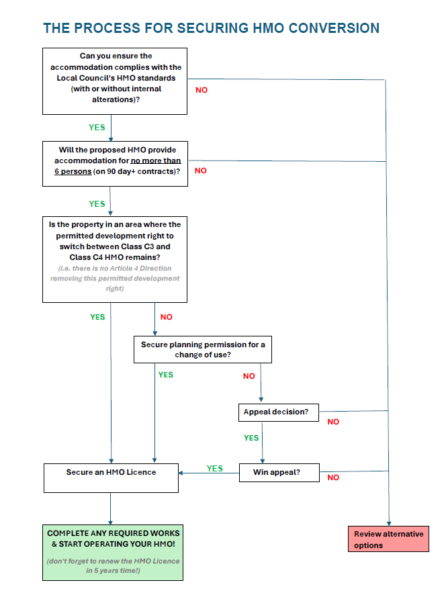


Local Authority
Greater LondonServices
Advice and Appraisals

Martin Moss from our London Office shares his insights into converting flats and houses to HMOs.
These advantages include:
Dwellinghouses vs HMOs – the differences
“Conventional” Class C3 dwellinghouses
Town Planning Legislation defines specific use classes for developments, with homes within “Use Class C3”
There is no upper limit on the number of occupants in a “Class C3 dwellinghouse” – which can be a studio unit, flat, maisonette or house. However, it must be:
Fully self-contained, with provision of the following behind a lockable “front door”:
Occupied as permanent living accommodation – for tenanted properties, residents need to be signed to rental contracts/leases of no less than 90 days and use the property as their sole or main residence.Occupied by persons living together as single household or two households. This allows for a room within your home to be let to either (i) a single lodger or (ii) two lodgers that are a couple or directly related (eg siblings).
HMOs
Occupation of a fully self-contained dwellinghouse by 3 or more unrelated individuals (each with their own private bedrooms) as their main residence for periods of 90 days or more and sharing the kitchen and/or bathroom and/or toilet facilities is defined as being Housing in Multiple Occupation (an “HMO”).
An HMO is treated as a single “unit” comprised of individually let bedsits (private rooms with at least a “bed” and somewhere to “sit”) and shared basic amenities within a property.
Critically, all individually let “bedsit rooms” within an HMO must lack at least one of the basic amenities – as creating self-contained accommodation will result in a new Class C3 dwellinghouse – which requires planning permission (and mandatory compliance with the Nationally defined Space Standards which require even the smallest 1 bed-1 person units to be at least 37sqm)
Whilst an HMO may be laid out exactly the same as a conventional house or flat, they are not within the same use classification as “a Class C3 dwellinghouse”, because the nature of the use and the associated impacts are different.
For clarification:
The distinction is very important as there is a National Permitted Development right that allows for dwellinghouses to switch between Class C3 use (occupation by 1-2 households); and Class C4 use (occupation by 3 or more unrelated persons) without the need for planning permission. There is no such provision for larger sui generis HMOs.
HMO standards and HMO licencing
Housing legislation has minimum size standard for non-self-contained “bedsit rooms” within HMOs of:
The National Standards require HMOs to provide adequate space heating and fire safety measures and also include a series of detailed requirements for toilet facilities, washing facilities, and particularly the kitchen facilities.
However, these are the baseline standards, as the legislation provides local councils to define their own higher standards – with a number of Councils identifying larger minimum bedsit sizes and providing very detailed standards that define the maximum number of persons required to share bathroom and kitchen facilities and what needs to be provided within these rooms. HMOs must be licenced by a Local Council to operate lawfully (with very limited exceptions). HMO licences confirm the accommodation is compliant with the relevant HMO standards detail the number of bedsit rooms and the maximum occupancy of each. Licences are granted for a 5-year period.
The removal of the right to switch between Class C3 dwellinghouses and Class C4 HMOs
It is not always possible to change a dwellinghouse to an Class C4 HMO as Local Councils have the ability to secure directions from the Secretary of State to remove national permitted development rights for defined areas – under Article 4 of the Town and Country Planning (General Permitted Development) (England) Order 2015).
These directions, informally known as “Article 4 directions” are often used to remove permitted development rights for minor works including laying hard surfacing and constructing walls in conservation areas – in order to preserve their character and appearance. However, Article 4 directions are increasingly being used by Councils to remove the permitted development right to switch between Class C3 dwellinghouses and Class C4 HMOs – usually due to local amenity issues arising from intensive occupation of housing stock (typically by students) and the loss of family housing impacting on the social balance of local communities.
Planning applications
In recognition of the important role HMOs play in providing a cheaper form of rented accommodation, where applicable, most Local Plan policies do seek to stop conversions of Class C3 dwellinghouse to HMOs altogether. Instead, they typically identify a series of “tests” to prevent overconcentrations of HMOs in certain areas. This means that those that first submit a planning application for a small Class C4 HMO on the street can often gain permission, whereas and those “latecomers” that apply to change their dwellinghouse after a number of others on the street have already done so, are often refused planning permission (due to an concentration of HMOs on the street having already been established). Applications for larger HMOs are inevitably more at risk of refusal because of the increased impacts associated with higher levels of occupancy.
Local Plan policies also identify a number of detailed requirements to ensure adequate car and cycle parking is provided (or a legal agreement to be agreed to prevent residents from applying for car parking permits where there isn’t sufficient on-street parking capacity). However, if the change of use is acceptable in principle, there is usually scope for these matters to be resolved and planning permission granted.
It is important to note that a number of Local Plan policies protect existing HMOs, so if a change of use is implemented following the grant of planning permission, it may not be possible to change the property back to a conventional (class C3) dwellinghouse in the future.
At Bell Cornwell, we leverage our experience and local knowledge to overcome planning complexities. This helps translate our clients’ visions into reality, creating prosperous spaces that respect an area’s unique needs and character.
Our experienced team of chartered planning consultants have significant expertise in respect of HMOs and can provide the following:









